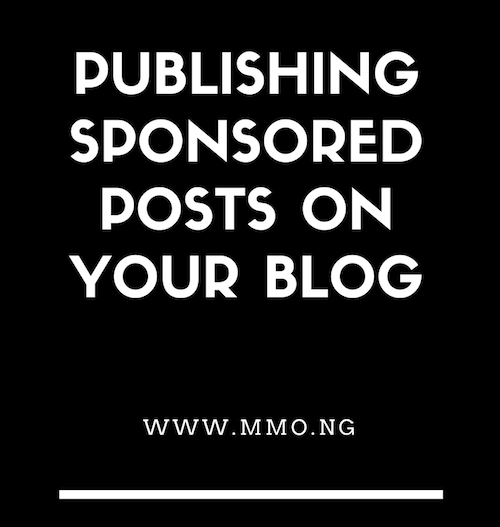Bloggers and online publishers, here is what you need to know about publishing sponsored posts on your blog.
No doubt, publishing sponsored posts on your blog is one of the smart ways to make money online. Lots of bloggers who have a measure of authority in a particular niche do this regularly. They use it as an online business model to generate income from their blogs. I also do this successfully on the Money Blog (this blog). In addition, I’ve been preaching the model to the readers of this blog. I wrote on why they should use sponsored posts model to make money blogging. However, I have not published anything about this important warning. Every blogger who makes money via sponsored/review posts should know and do this.
Warning about Publishing Sponsored Posts on your Blog
According to the “Best practices for bloggers reviewing free products they receive from companies” published by Google’s Webspam team in March 2016. You need to take note of the following warnings in order to be compliant with Google Webmaster Guidelines.
1. Use the Nofollow tags on links/URLs. Use the tag on links which take readers back to the brand’s site. Using Dofollow tags in exchange for payment are against Google guidelines on link schemes. These are not organic links. You need to “Nofollow” the links/URLs. Bloggers are advised to use the Nofollow tag on all such links.
2. Disclose the relationship. In the sponsored post, let your users know they’re reading/viewing a sponsored content. Also, you can follow the online web publishing guidelines specific to the country you are reading this from. posting Bloggers are advised to disclose the relation at the top of the content, in case users don’t read the entire sponsored post. You can write something like, “Sponsored Content” on the first line of the post and briefly disclose why you are posting the content.
And of course…
3. Create compelling, unique content
The most successful blogs offer their visitors a compelling reason to come back. As a blogger, you should try to become the go-to source of information in your topic area, cover a useful niche that few others are looking at, or provide exclusive content that only you can create due to your unique expertise or resources.
In addition to these, you also need to
4. Use hashtags such as #sponsored, #ad, #advertising when sharing the sponsored posts on social media like Facebook, Twitter and Instagram
5. Don’t post fake reviews. Stay authentic! Don’t give raving endorsements of a product or service you don’t like, just because it is paid for.
You may ask, why do I need to do this? What if the brand does not want people to know that the post was sponsored? My question is are you running a blogging business (Business blogging) or just blogging? If you are running a business on your blog and you want it to last, then you need to do what will keep your blog see by your potential clients. Not adhering to the warnings by Google Webspam (the Federal Trade Commission and consumer policy), means you want to run your blogging business to a halt.







Hello Adesoji. Thanks for pointing that out. I use a WordPress plugin (External links) to make all outgoing links a nofollow even if it’s a natural linking to another blog (like you did with The Google webmaster blog link). I hope It’s not wrong?
I await your response.
Regards,
Simeon Udoh
Hi Simeon,
That’s good to know. I use the same plugin too. I don’t think it’s wrong to make all outgoing (external) links a nofollow. Just make sure you have a good measure on internal links that are dofollow.
Hello Adesoji, Thanks for your response. I’m glad to hear you use it too. I blog at TechViber.com and I’d appreciate if you can visit my blog and lemme know what you think?
Have a nice day.
Regards,
Simeon Udoh.
Hey!
I checked your blog. You’re doing well but you need to work on your content distribution.
Thanks for the response. I use CloudFlare for content delivery and Jetpack Image Performance module to serve images from WordPress content delivery network too. Can you please tell how to improve it as per your comment?
I said content distribution, not content delivery.
I’d always ensure most of my sponsored post are No-follow tag (I also added it on my sponsored page). Can one include sponsored disclaimer at the end of the post?
Regards
Tunde
Yes but it’s best to include the disclaimer at the beginning of the post.
Okay.. Please, can I get a sample of one your sponsored post so I can know how you append the disclaimer.
I’ve done like two sponsored post on my blog and I didn’t include them
Please, check http://www.mmo.ng/binomo-broker/
Thanks for sparing time to answer my question and providing an example. I like the way you express your disclaimer, neither at the beginning nor at the end.
One more question, is it necessary I let brands know that I will put a disclaimer in the sponsored post?
Thanks so much for replying..
It is necessary to let them know. Brands are also required to let users know they sponsored the post.
Thanks for the response. Sorry for disturbing but can I get an article on how to work on my content distribution that is newbie friendly (I’m a Newbie myself ).
Content distribution simply means distributing your content effectively on other platforms different from your blog. Hope you understand this?
This is good and very informative
Thanks for sharing this awesome and wonderful info
Nice work brother…
Thanks for this wonderful post.
This will help me a lot whenever a sponsored post comes to me.